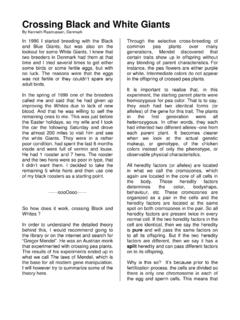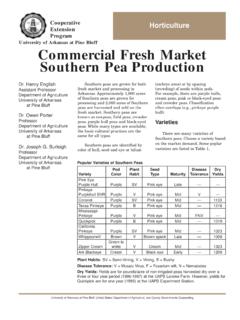Transcription of Ecology and Conservation of Purple Milkweed
1 Purple Milkweed ( asclepias purpurascens ) is an attractive and uncommon Milkweed native to the eastern United States. The plant was once a frequent member of the savannas, open oak woodlands, and deep-soil prairies of the tallgrass prairie complex (Cochrane and Iltis 2000) but today is rare and has become the focus of special Conservation efforts in several states. According to the USDA Plants Database, Purple Milkweed is endangered in Wisconsin, threatened in Massachusetts, and of special concern in Tennessee and Connecticut. In Rhode Island, it is listed as historical. Proposals for Conservation of Purple Milkweed in Michigan (Vande Water Natural Resources 2003) and New England have been made (Farnsworth and DiGregorio 2001).
2 At Pleasant Valley Conservancy State Natural Area, in southcentral Wisconsin, populations of this species arose spontaneously following restoration of the oak savannas. Greenhouse and transplant studies, have permitted further expansion of the species at this site. These studies and our field observations are providing insights into why Purple milkweeds might be rare, and offer hope for the eventual reestablishment in areas where it was historically the State Herbarium at the University of Wisconsin Madison, the first dated record for Purple Milkweed in Wisconsin is 1877, although an undated collection by Increase A. Lapham is probably older.
3 A total of 35 collections exist, and, except for two records from Winnebago County, all the records are from counties in the southern part of the Characteristics of MilkweedsThe Milkweed flower is an unusually complex structure, sometimes called bizarre because of the extreme way that the blossom is constructed. The reproductive biology of the Milkweed is rivaled only by that of the orchid in complexity (Wyatt 1976). In addition to the petals and sepals, which project downward, the flower has a complex upward-projecting structure, unique to milkweeds, called the corona. The corona consists of five petal-like structures called hoods that surround the stigma.
4 Each hood has a projection called a horn that bends down toward the stigma, where the nectar is stored. Associated with the corona is the female structure, called the gynostegium, which consists of parts of the stamens, anther, and stigma, all fused together. Ecology and Conservation of Purple Milkweed Thomas D. Brock Fred Professor of Natural Sciences Emeritus, University of Wisconsin-MadisonAbstract Purple Milkweed ( asclepias purpurascens ) is a relatively rare member of the flora of oak savannas and open oak woodlands. It is endangered in several states and has been the subject of special Conservation efforts. A number of native populations of this species arose spontaneously at Pleasant Valley Conservancy State Natural Area in southcentral Wisconsin after oak savanna restoration was initiated in 1997.
5 Ecological observations of permanently marked stands made over a ten year period have shown that growth is highly variable from year to year, and flowering and seed set are sporadic and unpredictable. Germination studies have determined that seed viability is very high. Greenhouse-raised plants have been successfully transplanted to the field and followed over a three-year period. Transplants have also been used in a forbs garden, where plants could be monitored more effectively. Pod formation and seed set are highly variable, both in the field and in the forbs garden, and may partly explain the rarity of this species. Originally published without illustrations in Ecological Restoration, Volume 27, number 3 (September 2009)Thomas D.
6 BrockEcology and Conservation of Purple MilkweedPage 2 This is where fertilization takes within the gynostegium is the pollen source. The pollen is not distributed as individual powdery grains, as in other plants, but is transferred all at once in a complex packet called a pollinium. This Y-shaped structure contains two arms, each of which has numerous pollen grains. Pollen is transferred when a leg of an insect feeding on the nectar-rich flower gets tangled in the pollinium. Upon travel by the insect to another flower, the pollinium may become deposited there, permitting fertilization to occur. Although the petals are colored and presumably aid in attracting insects, it is probably the pigmented corona which is the principal attractant for the insect.
7 In A. purpurascens both petals and corona are an intense Purple Pleasant Valley Conservancy, Purple Milkweed exists as a long-lived perennial, although it does not appear aboveground every year. Culture in the greenhouse and by transplants has indicated that the plant first produces flowers during the second or third growing season. Although some Milkweed species spread clonally by underground rhizomes, growth of Purple Milkweed is never clonal. At a given site anywhere from one to nine stems may develop, presumably all from the same root stock. Not all of these stems produce flowers. There are no special nutrient or soil conditions required, and seed germination and growth under greenhouse conditions are usually quite other species of milkweeds develop much more favorably at Pleasant Valley Conservancy than Purple milkweeds.
8 Common (A. syriaca), whorled (A. verticilllata), poke (A. exaltata), and swamp (A. incarnata) milkweeds all grow quite well. Although it was not originally present at Pleasant Valley Conservancy, butterfly Milkweed (A. tuberosa) has also developed quite well from seed in planted prairies, as well as from greenhouse-grown transplants. Of these, only poke Milkweed could be considered a savanna Appearance of Purple Milkweed after RestorationWhen major restoration work began at Pleasant Valley Conservancy in 1997, the oak savannas were heavily degraded by invasive shrubs (honeysuckle [Lonicera spp.], buckthorn [Rhamnus cathartica], prickly ash [Zanthoxylum americanum]) and undesirable trees (black walnut [Juglans nigra], black cherry [Prunus serotina], slippery elm [Ulmus rubra]), which were crowding out the mature open-grown savanna oaks (Brock and Brock 2006).
9 Restoration consisted of removal of these invasive trees and shrubs (cutting followed by herbicide treatment of the cut stumps) and controlled 1999, a year after the first clearing and two controlled burns of a ha white oak savanna, a single population of Purple Milkweed appeared. Over the next two years, two more populations appeared in this same area. As further restoration work in other parts of the Conservancy occurred, more populations arose. At present, 12 separate populations are known, in both white oak and bur oak savannas, throughout about 20 hectares of restored savannas. Each population has been marked with a permanent numbered metal stake.
10 Although most of these populations appear yearly, the extent of growth and flowering is highly variable from year to year. Also, several populations have disappeared for a year or two and then Pleasant Valley Conservancy, Purple Milkweed is primarily a species of oak savanna, a habitat with widely scattered open-grown oaks. Other habitats in which it maintains populations in Wisconsin include roadsides, the edges of oak woodlands, and mesic prairies (Cochrane and Iltis 2000). At the conservancy, we measured the canopy cover for each of the stands using vertical photography with a fish-eye lens, a technique widely used to determine canopy cover in forests.






